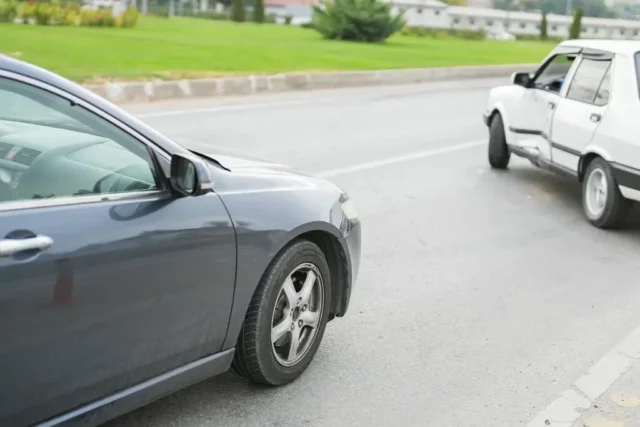The first thing to do after a T-bone car accident is to make sure everyone is safe and notify the authorities when serious injury, death, or heavy vehicle damage has occurred. Most states require you to report the situation to the police immediately and stay at the scene. It will also be beneficial to receive a police report for evidence later.
While they are most common in intersections, drivers must always be aware. These types of collisions can result in serious injury and even death. T-bones may cause your vehicle to lose control and crash into other vehicles, causing further harm. A T-bone can lead to multiple types of car accidents like:
If you’ve been involved in a T-bone accident, you may qualify for damages. Your award amount is based on the unique circumstances of your accident. Call a lawyer using the link below to sign up for a free consultation.
Free Auto Accident Evaluation
Hurt in a wreck that wasn’t your fault? Click here to speak with a nearby attorney for FREE about your Auto Accident claim.
or call (888)-927-3080
What is a T-Bone Car Accident?
A T-bone accident is when the front of one vehicle collides with the side of another. This type of accident is often referred to as a T-bone accident because the shape at the point of impact looks like the letter “T.”
It’s one of the more common types of crashes, accounting for 22% of all passenger vehicle accident deaths in 2021. The reason it’s so damaging to drivers and passengers is that people are less protected by the vehicle when hit from the side.
What Causes T-Bone Car Accidents?

A T-bone car accident typically happens when one driver fails to yield when another driver has the right-of-way.
Left turn T-bone accidents can occur at stoplights or 4-way stop signs. Sometimes T-bones happen when a driver goes through a red light, speeds up through a yellow left turn, or fails to stop at a stop sign. Other causes of T-bone accidents may include:
- Distracted driving: texting and driving is never safe
- Drowsy driving: driving while sleepy often results in a collision
- Driving under the influence of drugs or alcohol
- Manufacturing problems: faulty brakes or other vehicle problems can cause a T-bone collision
If you prove that what caused your T-bone collision was negligence from the other driver, you may qualify for damages.
How to Avoid a T-Bone Car Crash
The main way to avoid T-bone car crashes is to be aware of other vehicles at all times. Do not make assumptions that other drivers will yield or stop, even if they’re supposed to do so.
Make sure you have the right-of-way during traffic situations like 4-way stops and left turns. Avoid recklessly rushing through stop lights and stick to a reasonable speed to retain traction for your vehicle.
What to Do at the Scene of a T-Bone Car Crash
During a T-bone car accident, follow the following steps to exchange info while following your state’s car accident laws. Try to collect as much evidence at the scene as possible to help your attorney put together your claim.
- Find a safe place to park your vehicle close to the accident and out of the way of other vehicles, if able. Stay as close to the scene as possible.
- Check for injuries. If you or your passenger has been badly injured, call 911 and go to the hospital.
- Collect insurance information from the other party involved. Do not admit fault.
- Take photos and videos that can be used as evidence.
- File a police report online or get the police report created by law enforcement at the scene. This may help you in your insurance claim.
- Contact an attorney who specializes in auto accident cases.
- Contact your insurance company. Doing so with your attorney can be helpful if that is possible.
Most states require you to stay on the scene and collect the other driver’s information anyways through their accident laws. There may be exceptions depending on your vehicle’s damages, but if you’re unsure, you should follow these general steps.
Who is At-Fault in a T-Bone Accident?
The driver who was negligent on the road by not following traffic signs or driving illegally is at-fault.
The driver who made the left turn into another car is usually at-fault in a T-bone crash. But not always. The fault is assigned to the driver who was distracted, impaired, or who broke a traffic law.
You may share fault in a T-bone accident if you acted negligently and contributed to your own damages. Your state may follow a comparative negligence system which distributes payouts based on the percentage of fault each party carries in an accident.
The judge may assign you a percentage of fault if you were speeding while someone made an illegal left-turn and T-boned your car. How much you’ll receive in your settlement may get reduced by your percentage of fault in comparative negligence states.
Common T-Bone Car Accident Injuries
T-bone accidents are side collisions, triggering forceful contact with the window, door, or the frame of the car. Bodily injury is very probable during these situations, and it can develop over time. Of course, the person closest to the point of impact is generally the most hurt. Go see your doctor after a T-bone accident, even if you think you’re fine.
Common injuries can be severe and may include:
- Paralysis
- Spine and neck injuries
- Concussion or other head injuries
- Broken bones
- Lacerations
- Whiplash
- Facial injuries
- Broken limbs
- Ribcage and chest injuries
Average Payout for T-Bone Accidents
The amount of your payout depends on:
- The damage to your vehicle
- The severity of your injuries
- The amount of time you’re unable to work
Your settlement is also affected by the laws of the state you live in and the circumstances of your accident.
Moderate settlements range between $25,000 to $100,000. Permanent injuries or long-term medical complications because of a T-bone accident can potentially result in more than $1 million in financial compensation.
Types of T-Bone Crashes You Should Consider
Knowing what type of T-bone crash you suffered will help your attorney organize your claim. If you’re 50% or more at-fault for a T-bone, you may not receive a settlement from the other driver depending on your state’s negligence rules.
Left-Turn T-Bone Car Accidents
T-bone accidents often occur at traffic intersections controlled by a stop light or stop sign. A driver might make a risky left turn. He assumes another driver will stop at a yellow light. If the driver goes through the yellow, he could end up hitting the car that was turning.
Intersection T-Bone Car Accidents
A driver could improperly pass through a stop sign or red light and strike the side of another vehicle in the intersection.
T-Bone Crashes Involving Trucks
These are common because the driver’s line of sight may be compromised, or because large trucks cannot stop short as fast as smaller vehicles.
Types of Damages in a T-Bone Accident Lawsuit
T-bone accident victims should be compensated for all crash-related losses. These are both measurable and non-measurable losses, including:
- Medical bills
- Wages lost due to missed work because of the accident
- Pain and suffering
- Emotional distress
- Damage to your vehicle
- Loss of consortium
Wrongful death damages may also be available if your loved one passed away from a T-bone collision.
IMPORTANT: Talk with an auto accident lawyer about the statute of limitations for filing a case in your state to recover damages.
Hire an Auto Accident Attorney to Cover Your T-Bone Case
An auto accident lawyer may be able to help you collect compensation from the other driver’s insurance company after a T-bone accident. A lawyer could gather evidence to show that another party was responsible.
Contact LegalASAP today. We will connect you with an attorney who specializes in auto accident claims in your state. LegalASAP is connected with over 500+ firms with thousands of experienced lawyers located throughout the United States.
Sign up for a free consultation today and find how much your claim may be worth from a local car accident lawyer before you settle with insurance.
Laura Schaefer
Laura Schaefer is the author ofThe Teashop Girls,The Secret Ingredient, andLittler Women: A Modern Retelling. She is also an active co-author or ghostwriter of several nonfiction books on personal and business development. Laura currently lives in Windermere, Florida with her husband and daughter and works with clients all over the world. Visit her online at lauraschaeferwriter.com and linkedin.com.


